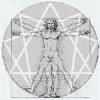“In the study of the law of octaves it must be remembered that octaves in their relation to each other are divided into fundamental and subordinate. The fundamental octave can be likened to the trunk of a tree giving off branches of lateral octaves. The seven fundamental NOTES OF THE OCTAVE and the two ‘intervals,’ the bearers of new directions, give altogether nine links of a chain, three groups of three links each. Fragments: Seven
“Like everything in nature the human body which represents a certain whole bears both within and without the same correlations. According to the number of the NOTES OF THE OCTAVE and its ‘intervals,’ the human body has nine basic measurements expressed by the numbers of a definite measure. In individuals these numbers of course differ widely but within certain definite limits. These nine basic measurements, giving a full octave of the first order, by combining in a certain definite way pass into measurements of subordinate octaves, which give rise in their turn to other subordinate octaves, and so on. In this way it is possible to obtain the measurements of any member or any part of the human body as they are all in a definite relationship one to another.” Fragments: Seven
“All cosmoses result from the action of the same forces and the same laws. Laws are the same everywhere. But they manifest themselves in a different, or at least, in not quite the same way on different planes of the universe, that is, on different levels. Consequently cosmoses are not quite analogous one to another. If the law of octaves did not exist, the analogy between them would have been complete, but owing to the law of octaves there is no complete analogy between them, just as there is no complete analogy between the different NOTES OF THE OCTAVE. It is only three cosmoses, taken together, that are similar and analogous to any other three. Fragments: Ten

